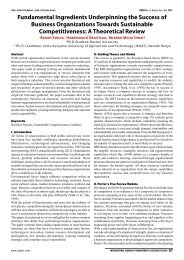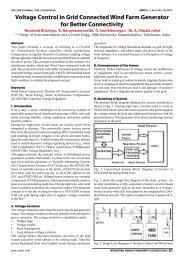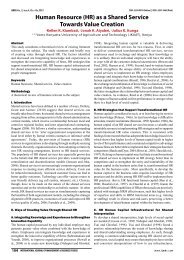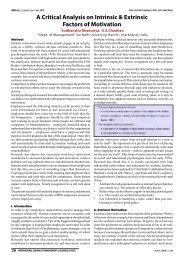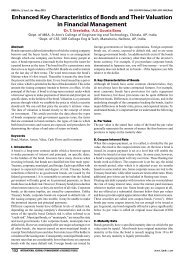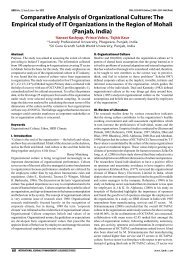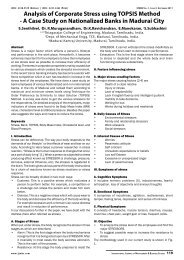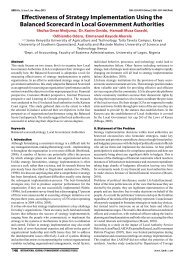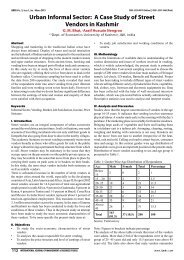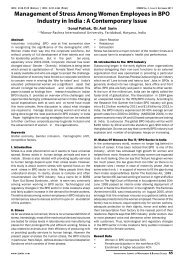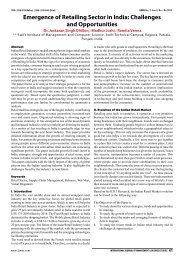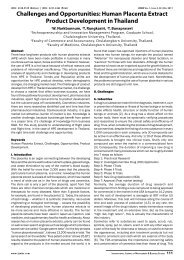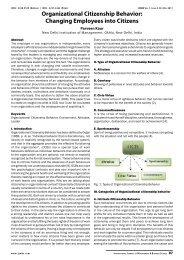Human Capital Investment as an Effective Tool for ... - Ijmbs.com
Human Capital Investment as an Effective Tool for ... - Ijmbs.com
Human Capital Investment as an Effective Tool for ... - Ijmbs.com
You also want an ePaper? Increase the reach of your titles
YUMPU automatically turns print PDFs into web optimized ePapers that Google loves.
IJMBS Vo l . 3, Is s u e 1, Ja n - Ma r c h 2013 ISSN : 2230-9519 (Online) | ISSN : 2231-2463 (Print)<br />
C. Method of Data Collection<br />
The method of data collection used in this study is questionnaire.<br />
Questionnaire according to Anikpo (2006) is “a list of questions<br />
designed to elicit in<strong>for</strong>mation from respondents by filling in the<br />
<strong>an</strong>swers in spaces provided <strong>for</strong> the purpose”. The questionnaire<br />
is the principal me<strong>an</strong>s <strong>for</strong> generating data. The <strong>for</strong>m of questions<br />
adopted in this questionnaire w<strong>as</strong> close ended. This me<strong>an</strong>s that<br />
none of the questions gave respondents’ the privilege to reveal<br />
their motives <strong>an</strong>d express their views. Close ended questions<br />
were adopted because of the problems of <strong>an</strong>alyzing divergent<br />
opinions. The research questionnaire adopted <strong>for</strong> the study w<strong>as</strong><br />
structured into two segments. The first is concerned with extracting<br />
biographic <strong>an</strong>d demographic data of the respondent; such <strong>as</strong> sex,<br />
age <strong>an</strong>d educational qualifications. Section B consist of questions<br />
which were used in testing the hypothesis of this study, related<br />
to the nature of respondents’ <strong>com</strong>pli<strong>an</strong>ce to investment in hum<strong>an</strong><br />
capital.<br />
D. Method of Data Analysis<br />
The statistical method used <strong>for</strong> data <strong>an</strong>alysis <strong>an</strong>d description of the<br />
responses is the chi-square. Chi-square is a statistical technique<br />
used in testing hypothesis. It is used to draw inference on whether a<br />
group of observed frequencies deviate remarkably from the group<br />
of expected frequencies, the use of chi-square however is done<br />
when the data are in nominal scale or ordinal scale. Generally,<br />
X 2 distribution involves a discrete variable <strong>an</strong>d it is employed<br />
in the <strong>an</strong>alysis of enumeration data. The <strong>for</strong>mula <strong>for</strong> calculating<br />
chi-square is given below <strong>as</strong>:<br />
Table 2: Number of Respondents by Age<br />
Respondents Number of Percentage (%)<br />
Respondents<br />
20 - 25 years 50 41.7<br />
26<br />
– 30 ײ 30 25.0 31<br />
– 35 ײ 15 12.5 36<br />
– 40 ײ 10 8.3 41 <strong>an</strong>d above 15 12.5<br />
Total 120 100%<br />
Source: Researcher’s Survey, 2012.<br />
Out of the 120 respondents that <strong>an</strong>swered the questionnaire in<br />
the three higher institutions, 41.7% (50) of them were in the age<br />
bracket of 20 – 25 years, 25% (30) to 26 – 30 age bracket, 12.5%<br />
(15) to 31 – 35 age bracket, 8.3% (10) to 36 – 40 age bracket <strong>an</strong>d<br />
12.5% (15) belong to 41 <strong>an</strong>d above age bracket.<br />
Table 3: Number of Respondents by Educational Qualification<br />
Respondents<br />
Number of<br />
Respondents<br />
Percentage (%)<br />
SSCE 15 12.5<br />
OND/NCE 30 25.0<br />
HND/B.Sc/B.A 60 50.0<br />
M.A/M.Sc 10 8.3<br />
OTHERS 5 4.2<br />
Total 120 100%<br />
Source: Researcher’s Survey, 2012.<br />
Where, O i<br />
= Observed frequency<br />
E i<br />
= Expected frequency<br />
X 2 = Chi Square<br />
With (R-1) (C-1) degree of freedom<br />
The decision rule is <strong>as</strong> follows: reject the null hypothesis if the<br />
calculated chi-square value is greater to the critical value otherwise<br />
accept null hypothesis.<br />
IV. Data Presentation <strong>an</strong>d Analysis<br />
This involves the presentation <strong>an</strong>d <strong>an</strong>alysis of the responses given<br />
to the questions <strong>as</strong>ked in the questionnaire that w<strong>as</strong> administered<br />
to the three categories of respondents <strong>as</strong> stated earlier.<br />
Table 1: Number of Respondents by Sex<br />
Respondents Number of Percentage (%)<br />
Respondents<br />
Male 80 66.7<br />
Female 40 33.3<br />
Total 120 100%<br />
Source: Researcher’s Survey, 2012.<br />
Out of the 120 respondents that <strong>an</strong>swered the questionnaire in the<br />
three selected higher institutions, 66.7% (80) of them were male<br />
while 33.3% (40) were female.<br />
Out of the 120 respondents that <strong>an</strong>swered the questionnaire in the<br />
three higher institutions, 12.5% (15) h<strong>as</strong> a maximum qualification<br />
of SSCE (Senior School Certificate Examination), 25% (30) were<br />
holders of OND/NCE (Ordinary National Diploma/National<br />
Certificate in Education), 50% (60) were holders of HND/B.<br />
Sc/B.A (Higher National Diploma/Bachelor of Science/Bachelor<br />
of Arts), 8.3% (10) were holders of M.A/M.Sc(M<strong>as</strong>ters of Arts/<br />
M<strong>as</strong>ters of Science) <strong>an</strong>d 4.2% (5) were holders of other degree<br />
(e.g. PhD holders).<br />
Table 4: <strong>Investment</strong> in <strong>Hum<strong>an</strong></strong> <strong>Capital</strong> through Education h<strong>as</strong><br />
made Signific<strong>an</strong>t Impact on Economic Growth <strong>an</strong>d Development<br />
of Nigeria<br />
Respondents UNIBEN AAU AUCHI<br />
EKPOMA POLY<br />
Total<br />
Agreed 25 35 30 90<br />
Disagreed 15 5 10 30<br />
Total 40 40 40 120<br />
Source: Researcher’s Survey, 2012.<br />
From the above table, out of the sample of 120 respondents taken,<br />
75% (90) of the sample respondents agreed that investment in<br />
hum<strong>an</strong> capital through education h<strong>as</strong> made signific<strong>an</strong>t impact on<br />
economic growth <strong>an</strong>d development in Nigeria, while 25% (30) of<br />
the sample respondents disagreed that hum<strong>an</strong> capital investment<br />
through education h<strong>as</strong> made signific<strong>an</strong>t impact on economic<br />
growth <strong>an</strong>d development in Nigeria.<br />
10 International Journal of M<strong>an</strong>agement & Business Studies<br />
www.ijmbs.<strong>com</strong>



